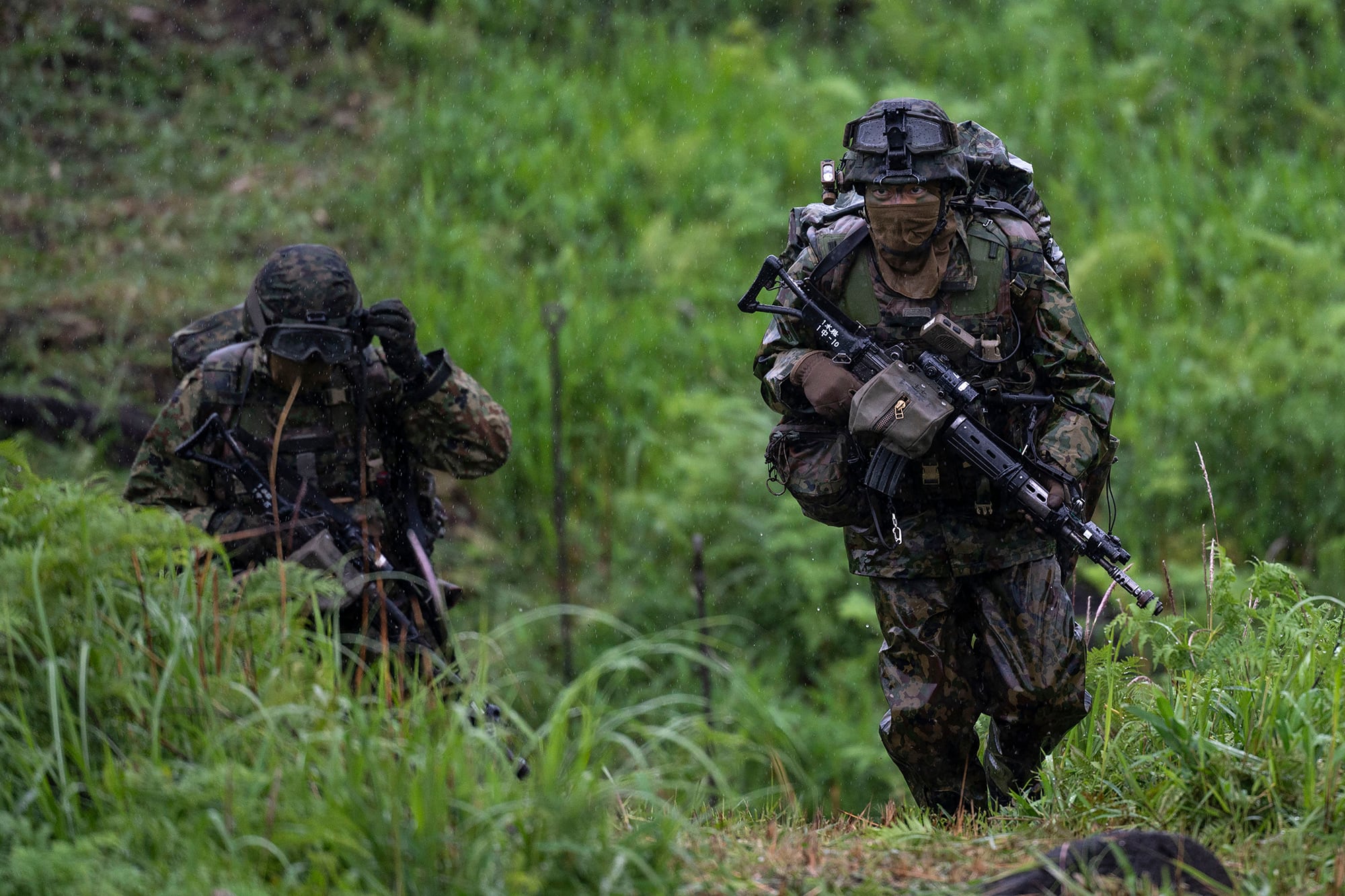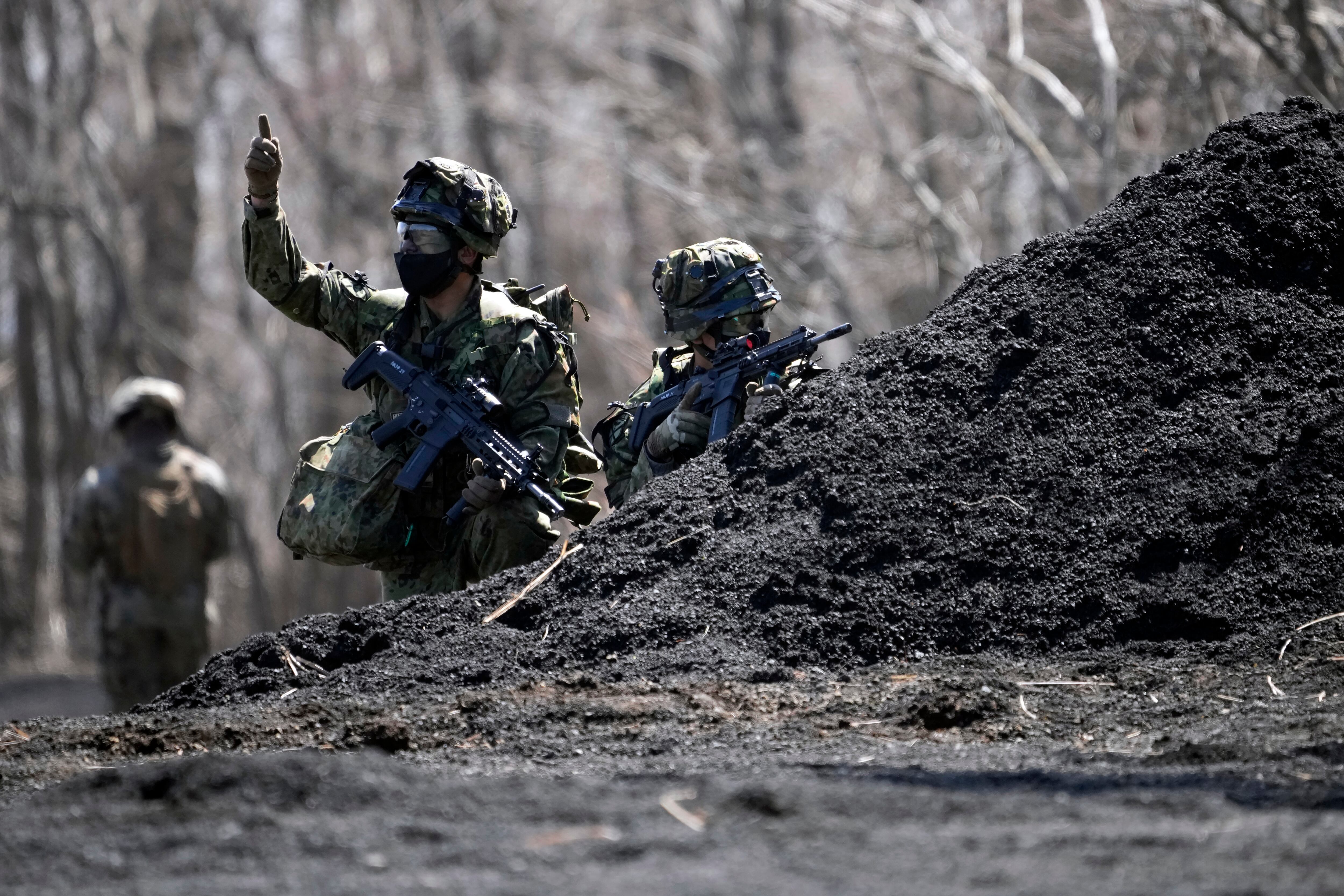WASHINGTON ― Japan on Wednesday will formally approve U.S. plans for a new Marine quick-reaction force on Okinawa and unveil plans to deepen military cooperation on Japan’s remote southwest islands near Taiwan, according to U.S. officials.
The new Marine littoral regiment would be stationed by 2025 and have advanced intelligence, surveillance, and reconnaissance, anti-ship, and transportation capabilities, U.S. officials said. The formal recognition is slated to come in a joint statement Wednesday after high-level talks between U.S. and Japanese national security officials.
The talks come as Tokyo signals its willingness to take on a more offensive role in the Pacific given its view of China as its biggest strategic challenge, newly outlined in Japan’s defense strategy last month. There are growing concerns in Japan and the U.S. that Taiwan may become a military flashpoint in the region as China regards the self-governing island as part of its own territory.
The joint statement will welcome Japan’s new aim to acquire “counterstrike capabilities” ― part of the nation’s plans to double its defense budget. The planned expenditure would make Japan the world’s third biggest military spender.
Wednesday, Defense Minister Yasukazu Hamada and Foreign Minister Yoshimasa Hayashi will meet with American counterparts Lloyd Austin and Antony Blinken. Japanese Prime Minister Fumio Kishida will then meet with U.S. President Joe Biden on Friday.
“The leaders will discuss our shared vision of a modernized alliance that will tackle 21st century challenges in the Indo-Pacific and around the world,” Brig. Gen. Pat Ryder, the Pentagon press secretary, said Tuesday. “China certainly will be a topic of discussion with our Japanese allies during the consultative meetings this week.”
Ryder said the meeting will provide an opportunity to discuss how to modernize the alliance and maintain a stable and secure Pacific, but declined to provide details on the new agreement.
The U.S. Marine Corps said publicly months ago it plans in 2025 to transform the Okinawa-based 12th Marine Regiment, an artillery unit, into a 12th Marine Littoral Regiment. However, Yomiuri Shimbun broke the news this week that Japan would formally agree to the quick-reaction force, meant to counter Chinese adventurism in the disputed Senkaku Islands.
Reportedly, the U.S. would not add troops on Okinawa, but reorganize some into a Marine littoral regiment, usually made up of 2,000 Marines. There are roughly 18,000 Marines in Japan, and while the Japanese government mostly supports U.S. bases, the presence of U.S. military personnel is unpopular among many Okinawans.
Okinawa Prefecture’s office in Washington said in a statement “it’s necessary to demand a firm explanation” of the planned changes from both governments. Okinawans are anxious about militarizing the southwestern islands, and strengthening them runs counter to their desire to reduce the base burden.
“We believe that the maintenance of order and stability in the region requires not only increased deterrence, but also constant diplomatic efforts,” said the statement.
The force structure changes compliment Marine Corps Commandant Gen. David Berger’s Force Design 2030, a plan to refashion the Corps with units that can be dispersible, highly mobile and hard to track.
The first of three planned units, the 3rd Marine Littoral Regiment, stood up last March in Hawaii. Officials have said the units will be armed with Navy strike missiles mounted on unmanned Joint Light Tactical Vehicles and able to target enemy ships; MQ-9A Reapers for unmanned extended-range intelligence, surveillance and reconnaissance, and a Ground/Air Task Oriented Radar, or G/ATOR.
U.S. officials describing the joint statement said the unit is the Marine Corps’ most advanced formation and would provide a stand-in force able to defend Japan and quickly respond to contingencies.
Tokyo, wary of rankling China, was long hesitant to allow such force posture changes, but it’s likely China’s launch of ballistic missiles into Japan’s exclusive economic zone in recent months helped upend that thinking, said Eric Sayers, a former senior adviser to U.S. Pacific Command who is now a fellow at the American Enterprise Institute.
“Having these modern, mobile, lethal Marine Corps units in the southwestern islands that can operate independently, operate alongside Japanese units, is sending a pretty strong signal to Beijing that the alliance will continue to upgrade itself and deter a [Chinese] course of action in Taiwan,” Sayers said.
RELATED

The two countries were also expected to hail the U.S. Air Force’s deployment of MQ-9 Reapers to Kanoya Air Base in southern Japan, where they have been conducting reconnaissance flights. Their patrols can collect information about Chinese military activity in the area — including signs it may be preparing to invade Taiwan — and about North Korea, which recently fired a ballistic missile over Japan.
Japan in December committed to acquiring long-range weapons and to continue increasing its defense budget as part of its latest National Security Strategy. Japan is seeking to buy U.S.-made Tomahawks and Joint Air-to-Surface Standoff Missiles that can reach potential targets in China ― and extend the range of its Type 12 missile.
In the new joint statement, the U.S. and Japan commit to exploring more effective alliance command-and-control relationships to improve interoperability and responsiveness, U.S. officials said this week.
According to former Biden National Security Council official Christopher Johnstone, the Japanese counter-strike capability would set the stage for a far deeper level of command-and-control integration with the U.S. than exists today. That’s because Japan will likely rely heavily on U.S. intelligence and targeting support as it develops the capability.
“Any scenario in which Japan is launching long-range cruise missiles at targets in China or North Korea would almost certainly coincide with U.S. military action; the allies therefore will need to develop an integrated process for target identification, prioritization, and deconfliction to maximize the effectiveness of U.S. and Japanese strike operations. This capacity does not exist today,” Johnstone, now with the Center for Strategic and International Studies, said in a recent paper.
The Center for Strategic and International Studies separately recommended, based on its recent war games of a Taiwan scenario, the U.S. prioritize deepening diplomatic and military ties with Japan. Based on its projections that the U.S. and Japan would suffer devastating losses of vital aircraft on the ground to China’s missiles, CSIS called for working with Tokyo to harden bases and plan for the use of civilian airfields.
For a Chinese takeover of Taiwan to be thwarted, it’s critical for the U.S. and its warplanes to be able to operate out of its bases in Japan, the think tank concluded. Without U.S. fighters based in Japan for escorts, U.S. bombers would be vulnerable to Chinese fighters armed with extreme-range air-to-air missiles ― and China would be able to concentrate on targets in Taiwan.
With reporting by Irene Loewenson, Megan Eckstein and Rachel. S. Cohen.
Joe Gould was the senior Pentagon reporter for Defense News, covering the intersection of national security policy, politics and the defense industry. He had previously served as Congress reporter.





